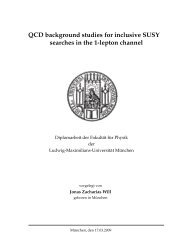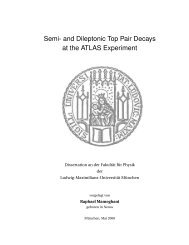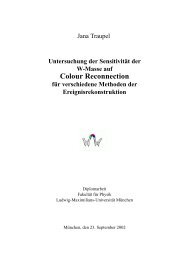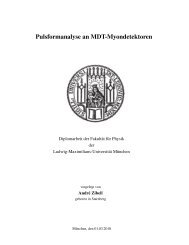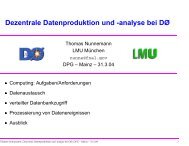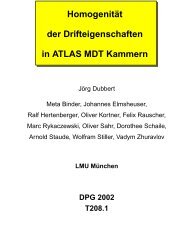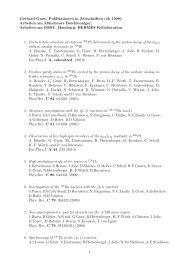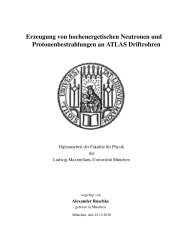development of micro-pattern gaseous detectors – gem - LMU
development of micro-pattern gaseous detectors – gem - LMU
development of micro-pattern gaseous detectors – gem - LMU
Create successful ePaper yourself
Turn your PDF publications into a flip-book with our unique Google optimized e-Paper software.
88 Chapter 9 Summary and Outlook<br />
stable flow and pressure conditions in the detector. In this way efficiencies <strong>of</strong> εcorr > 95% could be<br />
achieved. Furthermore, an influence <strong>of</strong> the temperature could be observed by cooling the detector<br />
which results in a decrease <strong>of</strong> εcorr. Monitoring the temperature additionally to flow and pressure<br />
control is thus recommended.<br />
The triple GEM detector presented in this work is filled with Ar/CO2 in the ratio 93/7 and provides<br />
an effective gain Ge f f = 10 4 . The applicable potential difference ∆UGEM is limited to approximately<br />
350 V due to frequent discharges <strong>of</strong> O(discharge) ≈ 1min −1 at higher values.<br />
The most stable working point <strong>of</strong> the triple GEM prototype 1.0 is:<br />
Eind = 1.25 kV<br />
for the electric fields in the gap regions and<br />
cm , Etrans1,2 = Eind = 2.00 kV<br />
cm<br />
∆UGEM1 = 320 V, ∆UGEM2 = 340 V and ∆UGEM3 = 360 V at the GEM foils, respectively. With this<br />
setup a stable operation <strong>of</strong> the detector in long term overnight-measurements is ensured.<br />
Furthermore, the signal rise time was analyzed as a function <strong>of</strong> electric field in the induction gap,<br />
Eind. In preparation for this analysis a GARFIELD / MAGBOLTZ simulation was implemented to<br />
study the electron drift time in the drift region <strong>of</strong> the detector depending on the electric field. It was<br />
found that the rise time by X-ray generated signals follows the drift time <strong>of</strong> electrons in the 3 mm<br />
induction gap. This could be observed for 55Fe measurements in the range 0.1 kV<br />
cm ≤ Eind ≤ 2.3 kV<br />
cm as<br />
well as for cosmic muons in the range 0.8 kV<br />
cm ≤ Eind ≤ 2.0 kV<br />
cm . This leads to the conclusion that the<br />
signals in the triple GEM detector are dominated by electrons and not by ion induced pulses.<br />
A prototype 2.0 with highly segmented strip anode is meanwhile realized. The active area <strong>of</strong> the<br />
anode is divided in 150µm thick copper strips with 250µm pitch. In cooperation with the TU Munich<br />
(E18) and HISKP Bonn a readout system is designed based on APV25 frontend modules. A first<br />
prototype 2.0 setup including the APV readout is probably available in early 2011.<br />
A complete readout system based on the GASSIPLEX frontend modules is implemented and data<br />
are taken just now. Mounted in a table top tracking station, a first sample <strong>of</strong> 1083 muon events is<br />
recorded. 90.6% <strong>of</strong> all tracks are considered for the fit that provides 79 ± 5µm spatial resolution <strong>of</strong><br />
the triple GEM detector.<br />
In combination with MICROMEGAS <strong>detectors</strong> developed simultaneously to this work this setup<br />
promises to be reliable for track reconstruction <strong>of</strong> cosmic muons with high resolution. Tests <strong>of</strong> the<br />
triple GEM <strong>detectors</strong>’ tracking capability <strong>of</strong> 140 GeV muons at the H8 beam line at CERN and their<br />
position accuracy <strong>of</strong> cosmic muon detection at increased background <strong>of</strong> gammas or neutrons are<br />
foreseen.



